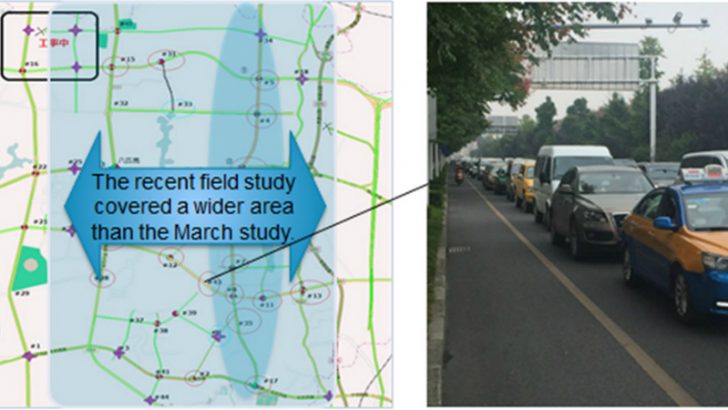
NTT DATA has announced the results of a traffic reduction study in Guiyang, Guizhou province in China. The study took place in the northwest corner of Guiyang. It focused on Guanshanhu district which historically suffers from traffic congestion. Taking part in the study were the Institute of Software, Chinese Academy of Sciences (ISCAS) and the city of Guiyang.
In March another study looked at a smaller area in the same district, mainly on a single street. Data was collected from 12 intersections during the morning and evening rush hour. This earlier study appears to have been a proof of concept. It is likely that it helped determine the parameters used for the latest study
Study process
The study collected data such as the license plate number from passing traffic. NTT identified 60 million cars passing through the 170 cameras at the intersections. This was analysed and fed into a data set that included the road and traffic information. A simulation then analyses the impact of changing multiple parameters on the traffic signals. These multiple results were evaluated and the ideal parameters identified. The settings on traffic signals were then updated to maximize flow.
It isn’t clear how quickly parameters for traffic signals were updated. Is was used to optimize 220 signals on 19 key junctions across the city. This led to a reduction in traffic congestion by 7% on average. The peak reduction was during evening rush hour where it was down by as much as 26%. This was achieved by increasing the number of vehicles passing through an intersection by 6.7% on average and 25% at the highest point in the mornings
Prototype to product
NTT DATA is looking to extend the solution across Guiyang and to other cities in China. The next phase is for NTT DATA, Guiyang and ISCAS to develop and integrate the solution across the whole traffic control system in the city. They will then look to commercialise the system and add real-time signal control.
Mr. Hiroyuki Kazama, Head of the Evolutional IT center at NTT DATA commented: “This latest field test proves that NTT DATA’s solution and supporting big data technology can be used to effectively alleviate real-life traffic congestion. This is the latest step forward in NTT DATA’s technological development to create a world-leading smart ITS solution that would optimize settings for traffic signals in a wide area on a real-time basis. In Guiyang, we now will strive to add real-time capabilities to the city’s traffic-control system, such as detecting signs of congestion to prevent occurrences across wide areas.”
NTT bets on smart cities
There is lots of opportunity in developing technology in smart cities. In a recent interview Wilhelm Nehring from ThyssenKrupp talked about the movement of people in smart cities using the latest elevator technology. This latest study and product from NTT DATA will look to help traffic in cities. NTT is hoping to increase its global revenue to 10 billion yen (US$100 million) by 2020. However driverless cars and people mobility systems may also help to cut traffic across cities.
Driverless cars may help to cut the number of vehicles in cities and they will be more prevalent by 2020. There is a new risk developing technology in this current climate of technological innovation. That is that the technology that you developed is disrupted by yet another technology. Uber are currently experimenting with driverless cars in Pittsburgh (not without issues). If successful it will completely change their business model. They will no longer need drivers for most location. This will also help Uber in its battle with legislators over workers rights. The impact of driverless cars on congestion is harder to quantify. If they reduce traffic it may mean that congestion becomes less of an issue.
Conclusion
This is a solution that will have a number of large cities taking a closer look. A lot of money is spent in optimising traffic flow to reduce the congestion around rush hours. This survey doesn’t mention pedestrian traffic as that always has an impact on traffic flow. It will be interesting to see if any junctions were tested for pedestrian prioritisation over vehicles. In many cities the pedestrians crossing places are often busier than the traffic ones and certainly hinder traffic flow.


























